Impact of Climate Conditions on the Sensitivity of Long-Term Annual River Flow in a Cascade-Dammed River System: The Brda River Case Study (Poland)
Abstract
1. Introduction
2. Materials and Methods
2.1. Study Area
2.2. Materials
2.2.1. Hydrological Data
2.2.2. Meteorological Data
2.2.3. Climate Scenarios
2.3. Methods
2.3.1. Delimiting Trends of Flow Variability
2.3.2. Sensitivity of Annual River Flow to Climate Conditions
3. Results
3.1. Reference Meteorological Conditions
3.2. Assessment of Long-Term River Flow Oscillation and Trends
3.3. Observed and Simulated River Flow
4. Discussion
4.1. Identification of Factors Determining River Flow Crisis for a Cascade-Dammed River
4.2. Sustainable Management Model for Cascade-Dammed Rivers Facing Climate Challenges
5. Conclusions
Author Contributions
Funding
Data Availability Statement
Acknowledgments
Conflicts of Interest
References
- Meresa, H.K.; Gatachew, M.T. Climate change impact on river flow extremes in the Upper Blue Nile River basin. J. Water Clim. Change 2018, 10, 759–781. [Google Scholar] [CrossRef]
- Roudier, P.; Jafet Andersson, C.M.; Donnelly, C.; Feyen, L.; Wouter Greuell, W.; Ludwig, F. Projections of future floods and hydrological droughts in Europe under a +2 °C global warming. Clim. Change 2016, 135, 341–355. [Google Scholar] [CrossRef]
- Madsen, H.; Lawrence, D.; Lang, M.; Martinkov, M.; Kjeldsen, T.R. Review of trend analysis and climate change projections of extreme precipitation and floods in Europe. J. Hydrol. 2014, 519, 3634–3650. [Google Scholar] [CrossRef]
- Kwok, R.; Untersteiner, N. The thinning of Arctic sea ice. Phys. Today 2011, 64, 36–41. [Google Scholar] [CrossRef]
- Shou, K.J.; Lin, J.F. Evaluation of the extreme rainfall predictions and their impact on landslide susceptibility in a sub-catchment scale. Eng. Geol. 2020, 265, 105434. [Google Scholar] [CrossRef]
- Prăvălie, R.; Nita, I.A.; Patriche, C.; Niculiță, M.; Birsan, M.V.; Roșca, B.; Bandoc, G. Global changes in soil organic carbon and implications for land degradation neutrality and climate stability. Environ. Res. 2021, 201, 111580. [Google Scholar] [CrossRef]
- Intergovernmental Panel on Climate Change (IPCC). Climate Change 2021: The Physical Science Basis. Contribution of Working Group I to the Sixth Assessment Report of the Intergovernmental Panel on Climate Change; Masson-Delmotte, V., Zhai, P., Pirani, A., Connors, S.L., Péan, C., Berger, S., Caud, N., Chen, Y., Goldfarb, L., Gomis, M.I., et al., Eds.; Cambridge University Press: Cambridge, UK, 2001. [Google Scholar] [CrossRef]
- Agenda for Sustainable Development 2030, Transforming Our World, A/RES/70/1. Available online: https://www.un.org/en/development/desa/population/migration/generalassembly/docs/globalcompact/A_RES_70_1_E.pdf (accessed on 16 December 2023).
- Sillmann, J.; Aunan, K.; Emberson, L.; Büker, P.; Van Oort, B.; O’Neill, C.; Otero, N.; Pandey, D.; Briseboiset, A. Combined impacts of climate and air pollution on human health and agricultural productivity. Environ. Res. Lett. 2021, 16, 093004. [Google Scholar] [CrossRef]
- Bentivoglio, F.; Calizza, E.; Rossi, D.; Carlino, P.; Careddu, G.; Rossi, L.; Costantini, M.L. Site-scale isotopic variations along a river course help localize drainage basin influence on river food webs. Hydrobiologia 2015, 770, 257–272. [Google Scholar] [CrossRef]
- Han, Z.; Long, D.; Fang, Y.; Hou, A.; Hong, Y. Impacts of climate change and human activities on the flow regime of the dammed Lancang River in Southwest China. J. Hydrol. 2019, 570, 96–105. [Google Scholar] [CrossRef]
- Tomer, M.D.; Schilling, K.E. A simple approach to distinguish land-use and climate-change effects on watershed hydrology. J. Hydrol. 2009, 376, 24–33. [Google Scholar] [CrossRef]
- Kim, J.; Choi, J.; Choi, C.; Park, S. Impacts of changes in climate and land use/land cover under IPCC RCP scenarios on streamflow in the Hoeya River Basin, Korea. Sci. Total Environ. 2013, 452–453, 181–195. [Google Scholar] [CrossRef] [PubMed]
- Zaghloul, M.S.; Ghaderpour, E.; Dastour, H.; Farjad, B.; Gupta, A.; Eum, H.; Achari, G.; Hassan, Q.K. Long Term Trend Analysis of River Flow and Climate in Northern Canada. Hydrology 2022, 9, 197. [Google Scholar] [CrossRef]
- Wang, C.; Zhang, H. Trend and Variance of Continental Fresh Water Discharge over the Last Six Decades. Water 2020, 12, 3556. [Google Scholar] [CrossRef]
- Meresa, H.K. River flow characteristics and changes under the influence of varying climate conditions. Nat. Resour. Model. 2020, 33, e12242. [Google Scholar] [CrossRef]
- Yang, D.; Li, C.; Hu, H.; Lei, Z.; Yang, S.; Kusuda, T.; Koike, T.; Musiake, K. Analysis of water resources variability in the Yellow River of China during the last half century using historical data. Water Resour. Res. 2004, 40, e002763. [Google Scholar] [CrossRef]
- Modi, A.; Tare, V.; Chaudhuri, C. Usage of long-term river discharge data in water balance model for assessment of trends in basin storages. Model. Earth Syst. Environ. 2021, 7, 953–966. [Google Scholar] [CrossRef]
- Lehner, B.; Czisch, G.; Vassolo, S. The impact of global change on the hydropower potential of Europe: A model-based analysis. Energy Policy 2005, 33, 839–855. [Google Scholar] [CrossRef]
- Morovati, K.; Tian, F.; Kummu, M.; Shi, L.; Tudaji, M.; Nakhaei, P.; Marcelo, O.A. Contributions from climate variation and human activities to flow regime change of Tonle Sap Lake from 2001 to 2020. J. Hydrol. 2023, 616, 128800. [Google Scholar] [CrossRef]
- Intergovernmental Panel on Climate Change (IPCC). Climate Change 2013: The Physical Science Basis. Contribution of Working Group I to the Fifth Assessment Report of the Intergovernmental Panel on Climate Change; Cambridge University Press: Cambridge, UK; New York, NY, USA, 2013. [Google Scholar]
- Du, N.; Fathollahi-Fard, A.M.; Wong, K.Y. Wildlife resource conservation and utilization for achieving sustainable development in China: Main barriers and problem identification. Environ. Sci. Pollut. Res. 2023, 1–20. [Google Scholar] [CrossRef]
- Moss, R.H.; Edmonds, J.A.; Hibbard, K.A.; Manning, M.R.; Rose, S.K.; van Vuuren, D.P.; Carter, T.R.; Emori, S.; Kainuma, M.; Kram, T.; et al. The next generation of scenarios for climate change research and assessment. Nature 2010, 463, 747–756. [Google Scholar] [CrossRef]
- Arora, V.K.; Scinocca, J.F.; Boer, G.J.; Christian, J.R.; Denman, K.L.; Flato, G.M.; Kharin, V.V.; Lee, W.G.; Merryfield, W.J. Carbon emission limits required to satisfy future representative concentration pathways of greenhouse gases. Geophys. Res. Lett. 2011, 38, e046270. [Google Scholar] [CrossRef]
- van Vuuren, D.P.; Edmonds, J.; Kainuma, M.; Riahi, K.; Thomson, A.; Hibbard, K.; Hurtt, G.C.; Kram, T.; Krey, V.; Lamarque, J.-F.; et al. The representative concentration pathways: An overview. Clim. Change 2011, 109, 5–31. [Google Scholar] [CrossRef]
- Chaturvedi, R.K.; Joshi, J.; Jayaraman, M.; Bala, G.; Ravindranath, N.H. Multi-Model Climate Change Projections for India under Representative Concentration Pathways. Curr. Sci. 2012, 103, 791–802. Available online: http://www.jstor.org/stable/24088836 (accessed on 14 March 2004).
- Gao, Y.; Fu, J.S.; Drake, J.B.; Lamarque, J.-F.; Liu, Y. The impact of emission and climate change on ozone in the United States under representative concentration pathways (RCPs). Atmos. Chem. Phys. 2013, 13, 9607–9621. [Google Scholar] [CrossRef]
- Marcinkowski, P. Projections of Climate Change Impact on Stream Temperature: A National-Scale Assessment for Poland. Appl. Sci. 2024, 14, 10900. [Google Scholar] [CrossRef]
- Peterson, B.J.; Holmes, R.M.; McCelland, J.W.; Vorosmarty, C.J.; Lammers, R.B.; Shiklomanov, A.I.; Shiklomanov, I.A.; Rahmstorf, S. Increasing River Discharge to the Arctic Ocean. Science 2002, 298, 2171–2173. [Google Scholar] [CrossRef]
- Berezovskaya, S.; Yang, D.; Kane, D.L. Compatibility analysis of precipitation and runoff trends over the large Siberian watersheds. Geophys. Res. Lett. 2004, 31, L21502. [Google Scholar] [CrossRef]
- Dai, A.; Qian, T.; Trenberth, K.E.; Milliman, J.D. Changes in Continental Freshwater Discharge from 1948 to 2004. J. Clim. 2009, 22, 2773–2792. [Google Scholar] [CrossRef]
- Shi, X.; Qin, T.; Nie, H.; Weng, B.; He, S. Changes in Major Global River Discharges Directed into the Ocean. Int. J. Environ. Res. Public Health 2019, 16, 1469. [Google Scholar] [CrossRef]
- Heinicke, S.; Volkholz, J.; Schewe, J.; Gosling, S.N.; Schmied, H.M.; Zimmermann, S.; Mengel, M.; Sauer, I.J.; Burek, P.; Chang, J.; et al. Global hydrological models continue to overestimate river discharge. Environ. Res. Lett. 2024, 19, 074005. [Google Scholar] [CrossRef]
- Chormański, J. Analysis of urbanization impact on changes in river discharge—A case study of the Biała River catchment. Stud. Geotech. Mech. 2012, 34, 19–32. [Google Scholar] [CrossRef]
- Duan, W.; He, B.; Chen, Y.; Zou, S.; Wang, Y.; Nover, D.; Chen, W.; Yang, G. Identification of long-term trends and seasonality in high-frequency water quality data from the Yangtze River basin, China. PLoS ONE 2018, 13, e0188889. [Google Scholar] [CrossRef] [PubMed]
- Habel, M.; Nowak, B.; Szadek, P. Evaluating indicators of hydrologic alteration to demonstrate the impact of open-pit lignite mining on the flow regimes of small and medium-sized rivers. Ecol. Indic. 2023, 157, 111295. [Google Scholar] [CrossRef]
- Foley, J.A.; DeFries, R.; Asner, G.P.; Barford, C.; Bonan, G.; Carpenter, S.R.; Champin, S.; Coe, M.; Daily, G.; Gibbs, H.; et al. Global Consequences of Land Use. Science 2005, 309, 570–574. [Google Scholar] [CrossRef]
- Dosdogru, F.; Kalin, L.; Wang, R.; Yen, H. Potential impacts of land use/cover and climate changes on ecologically relevant flows. J. Hydrol. 2020, 584, 124654. [Google Scholar] [CrossRef]
- Szatten, D.; Habel, M. Effects of Land Cover Changes on Sediment and Nutrient Balance in the Catchment with Cascade-Dammed Waters. Remote Sens. 2020, 12, 3414. [Google Scholar] [CrossRef]
- Feranec, J.; Jaffrain, G.; Soukup, T.; Hazeu, G. Determining changes and flows in European landscapes 1990–2000 using CORINE land cover data. Appl. Geogr. 2010, 30, 19–35. [Google Scholar] [CrossRef]
- Obodovskyi, O. River Runoff in Ukraine Under Climate Change Conditions; LAP Lambert Academic Publishing: Kiev, Ukraine, 2020; p. 180. [Google Scholar]
- Cui, T.; Tian, F.; Yang, T.; Wen, J.; Khan, M.Y.A. Development of a comprehensive framework for assessing the impacts of climate change and dam construction on flow regimes. J. Hydrol. 2020, 590, 125358. [Google Scholar] [CrossRef]
- Szmańda, J.B.; Gierszewski, P.J.; Habel, M.; Luc, M.; Witkowski, K.; Bortnyk, S.; Obodovskyi, O. Response of the Dnieper River fluvial system to the river erosion caused by the operation of the Kaniv hydroelectric power plant (Ukraine). Catena 2021, 202, 105265. [Google Scholar] [CrossRef]
- Lindström, G.; Johansson, B.; Persson, M.; Gardelin, M.; Bergström, S. Development and test of the distributed HBV-96 hydrological model. J. Hydrol. 1997, 201, 272–288. [Google Scholar] [CrossRef]
- Booij, M.J.; Krol, M.S. Balance between calibration objectives in a conceptual hydrological model. Hydrol. Sci. J. 2010, 55, 1017–1032. [Google Scholar] [CrossRef]
- Osuch, M.; Lawrence, D.; Meresa, H.K.; Napiórkowski, J.J.; Romanowicz, R.J. Projected changes in flood indices in selected catchments in Poland in the 21st century. Stoch. Environ. Res. Risk Assess. Res. J. 2017, 31, 2435–2457. [Google Scholar] [CrossRef]
- Tian, F.; Hou, S.; Morovati, K.; Zhang, K.; Nan, Y.; Lu, X.X.; Ni, G. Exploring spatio-temporal patterns of sediment load and driving factors in Lancang-Mekong River basin before operation of mega-dams (1968–2002). J. Hydrol. 2023, 617, 128922. [Google Scholar] [CrossRef]
- Mekonnen, D.G.; Moges, M.A.; Mulat, A.G.; Shumitter, P. The impact of climate change on mean and extreme state of hydrological variables in Megech watershed, Upper Blue Nile Basin, Ethiopia. In Extreme Hydrology and Climate Variability; Melesse, A.M., Abtew, W., Senay, G., Eds.; Elsevier: Amsterdam, The Netherlands, 2019; pp. 123–135. [Google Scholar] [CrossRef]
- Acharyya, R.; Mukhopadhyay, A.; Habel, M. Coupling of SWAT and DSAS Models for Assessment of Retrospective and Prospective Transformations of River Deltaic Estuaries. Remote Sens. 2023, 15, 958. [Google Scholar] [CrossRef]
- Belletti, B.; Garcia de Leaniz, C.; Jones, J.; Bizzi, S.; Börger, L.; Segura, G.; Castelletti, A.; van de Bund, W.; Aarestrup, K.; Barry, J.; et al. More than one million barriers fragment Europe’s rivers. Nature 2020, 588, 436–441. [Google Scholar] [CrossRef]
- Habel, M.; Mechkin, K.; Podgorska, K.; Saunes, M.; Babiński, Z.; Chalov, S.; Absalon, D.; Podgórski, Z.; Obolewski, K. Dam and reservoir removal projects—A mix of social-ecological trends and cost-cutting attitudes. Sci. Rep. 2020, 10, 19210. [Google Scholar] [CrossRef]
- Gierszewski, P.J.; Habel, M.; Szmańda, J.; Luc, M. Evaluating effects of dam operation on flow regimes and riverbed adaptation to those changes. Sci. Total Environ. 2020, 710, 136202. [Google Scholar] [CrossRef]
- Szatten, D.; Brzezińska, M.; Bosino, A. New sediment continuum measurements in the Brda River (Poland): The results of the functioning of the 50-year Koronowo dam. J. Soils Sediments 2023, 23, 3219–3240. [Google Scholar] [CrossRef]
- Revenga, C.; Brunner, J.; Henniger, N.; Kassem, K.; Payne, R. Pilot Analysis of Global Ecosystems: Freshwater Systems; World Resources Institute: Washington, DC, USA, 2020; p. 100. [Google Scholar]
- Szatten, D.; Habel, M.; Babiński, Z. Influence of Hydrologic Alteration on Sediment, Dissolved Load and Nutrient Downstream Transfer Continuity in a River: Example Lower Brda River Cascade Dams (Poland). Resources 2021, 10, 70. [Google Scholar] [CrossRef]
- Jacob, D.; Petersen, J.; Eggert, B.; Alias, A.; Christensen, O.B.; Bouwer, L.M.; Braun, A.; Colette, A.; Déqué, M.; Georgievski, G.; et al. EURO-CORDEX: New high-resolution climate change projections for European impact research. Reg. Environ. Change 2014, 14, 563–578. [Google Scholar] [CrossRef]
- Konukcu, F.; Istanbulluoglu, A.; Kocaman, I. Determination of the water yields for small basins in semi-arid areas: Application of the modified Turc method to the Turkey’s conditions. J. Cent. Eur. Agric. 2005, 6, 263–268. Available online: https://jcea.agr.hr/articles/257_DETERMINATION_OF_THE_WATER_YIELDS_FOR_SMALL_BASINS_IN_SEMI_ARID_AREAS_APPLICATION_OF_THE_MODIFIED_TURC_METHOD_TO_THE_TURKEY_S_C_en.pdf (accessed on 3 April 2025).
- Horvat, B.; Rubinic, J. Annual runoff estimation—An example of karstic aquifers in the transboundary region of Croatia and Slovenia. Hydrol. Sci. J. 2006, 51, 314–324. [Google Scholar] [CrossRef]
- Snizhko, S.I.; Obodovskyi, O.G.; Shevchenko, O.G.; Grebin, V.V.; Didovets, I.S.; Kuprikov, I.V.; Pochaievets, O.O. Regional Assessment Changes of The Rivers Runoff of Ukrainian Carpathians Region Under Climate Changes. Ukr. Geogr. 2020, 2, 20–29. [Google Scholar] [CrossRef]
- Map of the Polish Hydrographic Division. Department of Hydrography and Morphology of River Channels Institute of Meteorology and Water Management. 2007. Available online: http://mapa.kzgw.gov.pl/ (accessed on 10 December 2016).
- Galon, R. Morfologia doliny i sandru Brdy. Stud. Soc. Scient. Tor. 1953, C, 1–6. [Google Scholar]
- Corine Land Cover. Copernicus Land Monitoring Service, 2018. Available online: https://sdi.eea.europa.eu/catalogue/copernicus/api/records/71c95a07-e296-44fc-b22b-415f42acfdf0?language=all (accessed on 4 December 2020).
- Jutrowska, E. Antropogeniczne Zmiany Warunków Hydrologicznych w Dorzeczu Brdy; Biblioteka Monitoringu Srodowiska: Bydgoszcz, Poland, 2007; p. 128. [Google Scholar]
- Studium Regionu Doliny Brdy; Biuro Planów Regionalnych: Warszawa, Poland, 1953.
- Pozwolenie Wodnoprawne na Szczególne Korzystanie z Wód Rzeki Brdy Dla Potrzeb Elektrowni Wodnej Smukała; Biuro Wojewody Kujawsko-Pomorskiego. 2004. Available online: http://archiwum.kujawsko-pomorskie.pl/index.php?option=com_content&task=view&id=20512&Itemid=665 (accessed on 10 September 2020).
- Szatten, D. Wpływ zabudowy hydrotechnicznej na występowanie ekstremalnych stanów wody na przykładzie Brdy skanalizowanej. Inżynieria Ekol. 2016, 46, 55–60. [Google Scholar] [CrossRef][Green Version]
- Urban, G. Ocena wybranych metod obliczania średniej dobowej, miesięcznej i rocznej wartości temperatury powietrza (na przykładzie Sudetów Zachodnich i ich przedpola). Opera Corcon. 2010, 47, 23–34. Available online: https://opera.krnap.cz/apex/apex_util.get_blob?s=6643063503717&a=103&c=6251526924540477&p=8&k1=926&k2=&ck=_PO5bGOfXQcH9Y5pVqgg_7N2W1FG2FMIXVVBuXWwdUYaOCK2lIvPWSKuO9Bojl0dA74EDCyNCCIzBfcTpmdyCw&rt=CR (accessed on 3 April 2025).
- Klemm, S. IOM Report. 39. Catalogue of National Standard Precipitation Gauges; World Meteorological Organization: Geneva, Switzerland, 1989; p. 50. [Google Scholar]
- Mezghani, A.; Dobler, A.; Haugen, J.E.; Benestad, R.E.; Parding, K.M.; Piniewski, M.; Kardel, I.; Kundzewicz, Z.W. CHASE-PL Climate Projection dataset over Poland—Bias adjustment of EURO-CORDEX simulations. Earth Syst. Sci. Data 2017, 9, 905–925. [Google Scholar] [CrossRef]
- Intergovernmental Panel on Climate Change (IPCC). Climate Change 2014: Synthesis Report. Contribution of Working Groups I, II and III to the Fifth Assessment Report of the Intergovernmental Panel on Climate Change; Pachauri, R.K., Meyer, L.A., Eds.; IPCC: Geneva, Switzerland, 2014; Available online: https://www.ipcc.ch/site/assets/uploads/2018/02/SYR_AR5_FINAL_full.pdf (accessed on 12 June 2023).
- Lukianets, O.I.; Obodovskyi, O.G.; Grebin, V.V.; Moskalenko, S.O.; Pochaievets, O.O.; Korniienko, V.O. Forecast estimates of water runoff of rivers of Ukraine on the basis of stochastic patterns of its long-term fluctuations. Ukr. Geogr. J. 2021, 4, 18–29. [Google Scholar] [CrossRef]
- Turc, L. Water Balance of Soils: Relationship Between Precipitation, Evapotranspiration and Runoff. Ann. Agron. 1954, 5, 491–595. [Google Scholar]
- Kożuchowski, K.; Żmudzka, E. Ocieplenie w Polsce, skala i rozkład sezonowy zmian temperatury powietrza w drugiej połowie XX wieku. Przegl. Geofiz 2001, Z.1–, 81–90. [Google Scholar]
- Piniewski, M.; Mezghani, A.; Szcześniak, M.; Kundzewicz, Z.W. Regional projections of temperature and precipitation changes: Robustness and uncertainty aspects. Meteorol. Z. 2017, 26, 223–234. [Google Scholar] [CrossRef]
- Trenberth, K.E.; Fasullo, J.T. An apparent hiatus in global warming? Earth’s Future 2013, 1, 19–32. [Google Scholar] [CrossRef]
- Wrzesiński, D.; Marsz, A.A.; Sobkowiak, L.; Styszyńska, A. Response of Low Flows of Polish Rivers to Climate Change in 1987–1989. Water 2022, 14, 2780. [Google Scholar] [CrossRef]
- Brzezińska, W.; Wrzesiński, D. Maximum River Runoff in Poland Under Climate Warming Conditions. Quaest. Geogr. 2025, 44, 85–105. [Google Scholar] [CrossRef]
- Priya, A.K.; Muruganandam, M.; Rajamanickam, S.; Sivarethinamohan, S.; Gaddam, M.K.R.; Velusamy, P.; Gomathi, R.; Gokulan, R.; Gurugubelli, T.R.; Muniasamy, S.K. Impact of climate change and anthropogenic activities on aquatic ecosystem—A review. Environ. Res. 2023, 238, 117233. [Google Scholar] [CrossRef]
- Rezvani, R.; Rahimi, M.M.; Na, W.; Najafi, M.R. Accelerated lagged compound floods and droughts in northwest North America under 1.5 °C–4 °C global warming levels. J. Hydrol. 2023, 624, 129906. [Google Scholar] [CrossRef]
- Gorączko, M. Przebieg i skutki wezbrań na Wiśle w rejonie Bydgoszczy w latach 2010–2011. In Gospodarowanie Wodą w Warunkach Zmieniającego Się Środowiska; Marszelewski, W., Ed.; Monografie Komisji Hydrologicznej PTG: Toruń, Poland, 2011; pp. 75–84. [Google Scholar]
- Choiński, A. Zróżnicowanie i Uwarunkowania Zmienności Przepływów Rzek Polskich; Scientific Society Press UAM: Poznań, Poland, 1988; p. 99. [Google Scholar]
- Vörösmarty, C.J.; Sharma, K.P.; Fekete, B.M.; Copeland, A.H.; Holden, J.; Marble, J.; Lough, J.A. The storage and aging of continental run off in large reservoir systems of the world. Ambio 1997, 26, 210–219. [Google Scholar]
- Obodovskyi, O.; Habel, M.; Szatten, D.; Rozlach, Z.; Babiński, Z.; Maerker, M. Assessment of the Dnieper Alluvial Riverbed Stability Affected by Intervention Discharge Downstream of Kaniv Dam. Water 2020, 12, 1104. [Google Scholar] [CrossRef]
- Zhang, Z.; Liu, J.; Huang, J. Hydrologic impacts of cascade dams in a small headwater watershed under climate variability. J. Hydrol. 2020, 590, 125426. [Google Scholar] [CrossRef]
- Directive 2000/60/EC of the European Parliament and of the Council of 23 October 2000 Establishing a Framework for Community Action in the Field of Water Policy. Available online: https://eur-lex.europa.eu/eli/dir/2000/60/oj (accessed on 21 October 2019).
- Lopez-Moreno, J.I.; Vicente-Serrano, S.M.; Beguerıa, S.; Garcıa-Ruiz, J.M.; Portela, M.M.; Almeida, A.B. Dam effects on droughts magnitude and duration in a transboundary basin: The Lower River Tagus, Spain and Portugal. Water Resour. Res. 2009, 45, W02405. [Google Scholar] [CrossRef]
- Fischer, G.; Heilig, G.K. Population momentum and the demand on land and water resources. Phil. Trans. R. Soc. 1997, 352, 869–889. Available online: https://www.jstor.org/stable/56531 (accessed on 14 January 2023). [CrossRef]
- Shiklomanov, I.A. The world’s water resources. In Proceedings of the International Symposium to Commemorate 25 Years of the IHD/IHP, Paris, France, 15–17 March 1990; UNESCO/IHP: Paris, France, 1991; pp. 93–126. [Google Scholar]
- Cosgrove, W.J.; Loucks, D.P. Water management: Current and future challenges and research directions. Water Resour. Res. 2015, 51, 4823–4839. [Google Scholar] [CrossRef]
- Mioduszewski, W. Mała retencja w lasach elementem kształtowania i ochrony zasobów wodnych. Stud. I Mater. Cent. Edukac. Przyr. -Leśnej 2008, 2, 33–48. Available online: http://malaretencja.pl/images/publikacje/W._Mioduszewski_MaaRetencjawLasach.pdf (accessed on 3 April 2025).
- Rozporządzenie Rady Ministrów z Dnia 18 Października 2016 r. w Sprawie Planu Gospodarowania Wodami na Obszarze Dorzecza Wisły. Journal of in Laws 2016, Item 1911. Available online: https://isap.sejm.gov.pl/isap.nsf/DocDetails.xsp?id=WDU20160001911 (accessed on 22 November 2023).
- Rozporządzenie Ministra Infrastruktury z Dnia 15 Lipca 2021 r. w Sprawie Przyjęcia Planu Przeciwdziałania Skutkom Suszy. Journal of Laws in 2021, Item 1615. Available online: https://isap.sejm.gov.pl/isap.nsf/DocDetails.xsp?id=WDU20210001615 (accessed on 22 November 2023).
- Rozporządzenie Ministra Infrastruktury z Dnia 18 Października 2022 r. w Sprawie Przyjęcia Planu Zarządzania Ryzykiem Powodziowym Dla Obszaru Dorzecza Wisły. Journal of Laws in 2022, Item 2739. Available online: https://isap.sejm.gov.pl/isap.nsf/DocDetails.xsp?id=WDU20220002739 (accessed on 22 November 2023).
- So, K.; Rogers, C.A.; Li, Y.; Arain, M.A.; Gonsamo, A. Retention forestry as a climate solution: Assessing biomass, soil carbon and albedo impacts in a northern temperate coniferous forest. Sci. Total Environ. 2024, 947, 174680. [Google Scholar] [CrossRef]
- Halperin, S.; Koehn, C.R.; Johnson, K.K.; Brandt, J.S. Systematic conservation planning for private working lands: Identifying agricultural protection areas for climate solutions, biodiversity habitat, and ecosystem services. Biol. Conserv. 2004, 297, 110735. [Google Scholar] [CrossRef]
- Zwierzchowska, I.; Fagiewicz, K.; Poniży, L.; Lupa, P.; Mizgajski, A. Introducing nature-based solutions into urban policy—Facts and gaps. Case study of Poznań. Land Use Policy 2019, 85, 161–175. [Google Scholar] [CrossRef]
- WWAP United Nations World Water Assessment Programme. The United Nations World Water Development Report 2018: Nature-Based Solutions for Water; UN Water Report: New York, NY, USA, 2018; Available online: https://unesdoc.unesco.org/ark:/48223/pf0000261424 (accessed on 16 June 2023).
- Hamidova, E.; Bosino, A.; Franceschi, L.; De Amicis, M. Nature-Based Solution Integration to Enhance Urban Geomorphological Mapping: A Methodological Approach. Land 2024, 13, 467. [Google Scholar] [CrossRef]
- Clayton, S.; Manning, C.M.; Krygsman, K.; Speiser, M. Mental Health and Our Changing Climate: Impacts, Implications, and Guidance; American Psychological Association, and ecoAmerica: Washington, DC, USA, 2017; p. 70. [Google Scholar]
- Fracasso, I.; Dinella, A.; Giammarchi, F.; Marinchel, N.; Kołaczek, P.; Lamentowicz, M.; Marcisz, K.; Łokas, E.; Miecznik, M.; Bragazza, L.; et al. Climate and human impacts inferred from a 1500-year multi-proxy record of an alpine peatland in the South-Eastern Alps. Ecol. Indic. 2022, 145, 109737. [Google Scholar] [CrossRef]
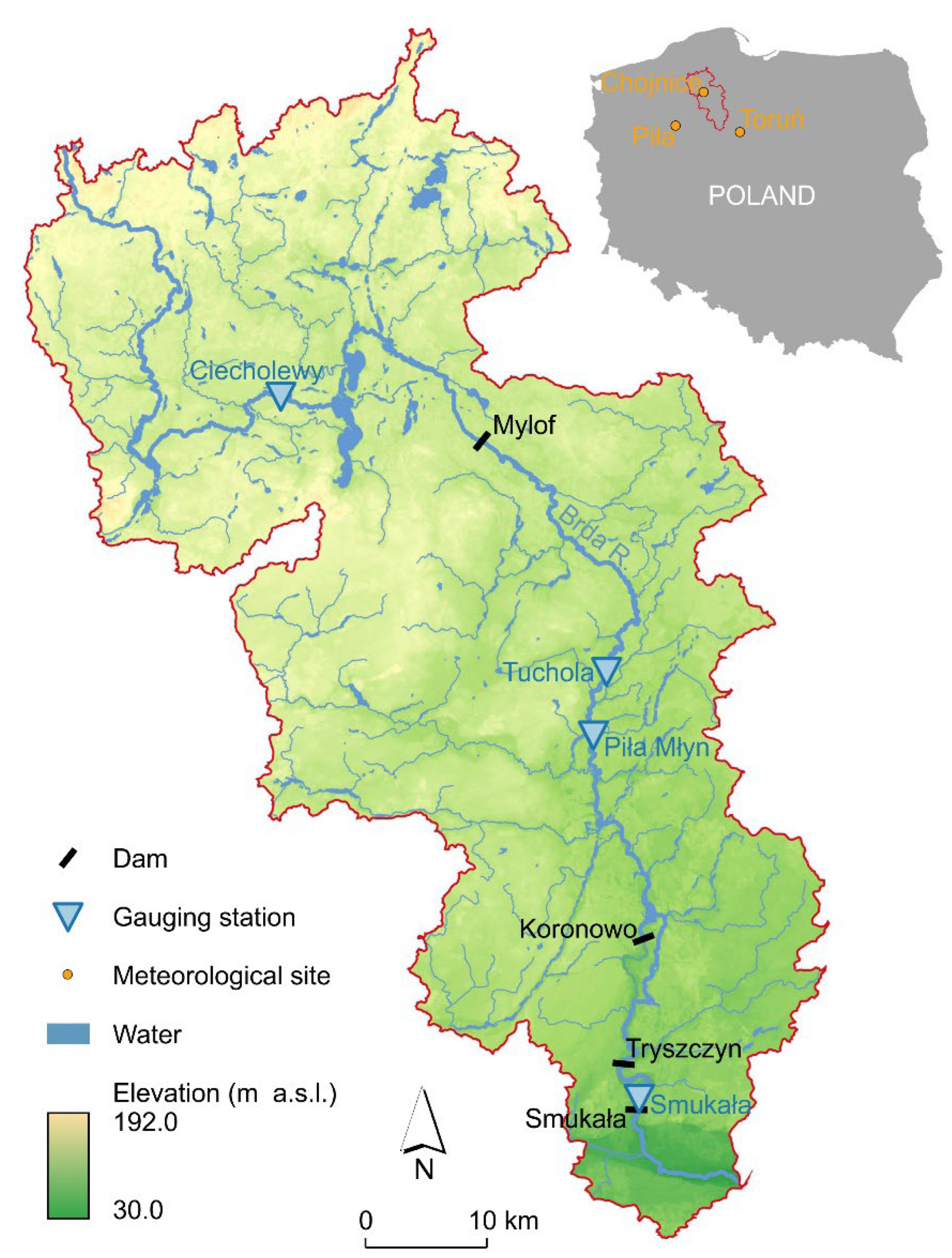
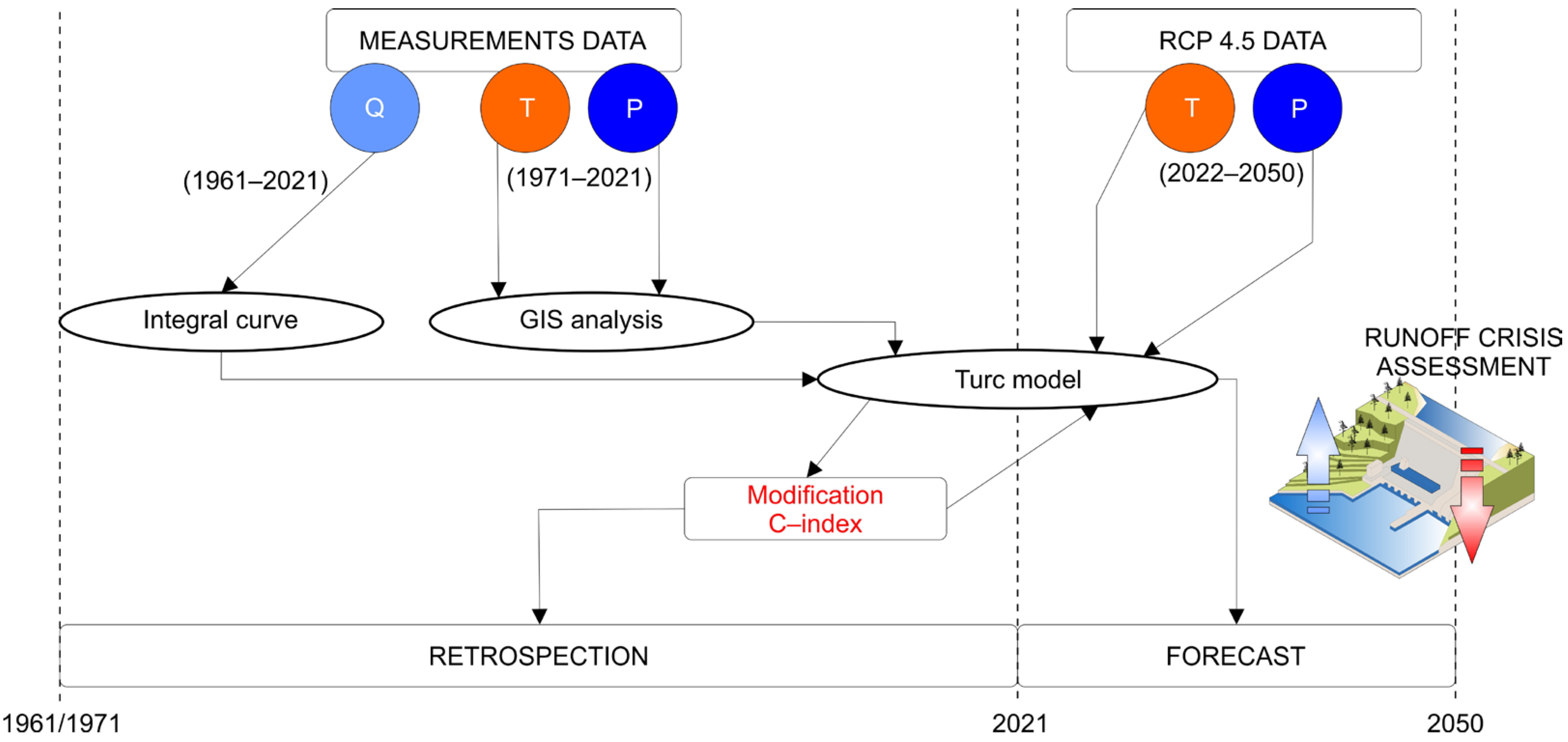
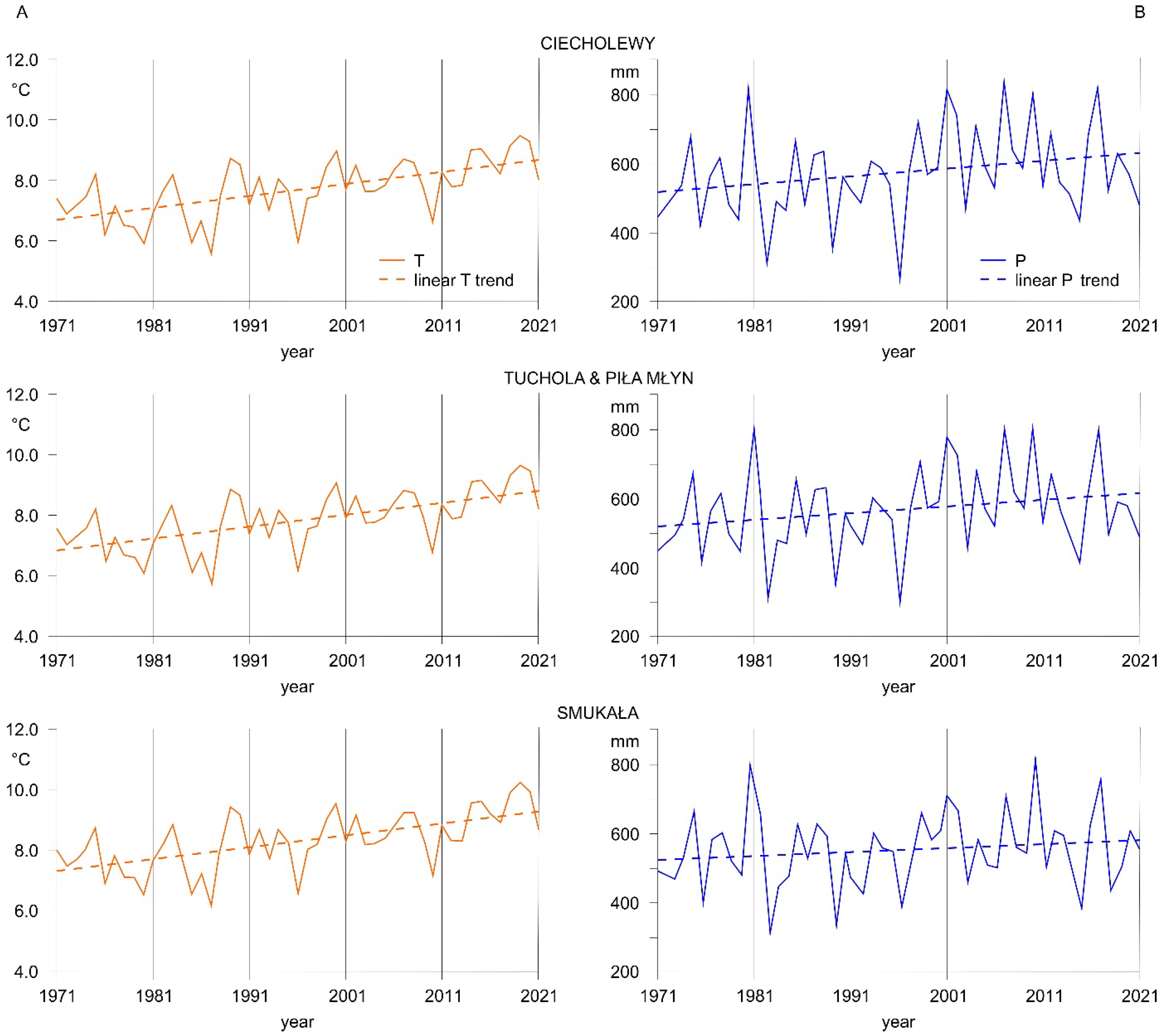
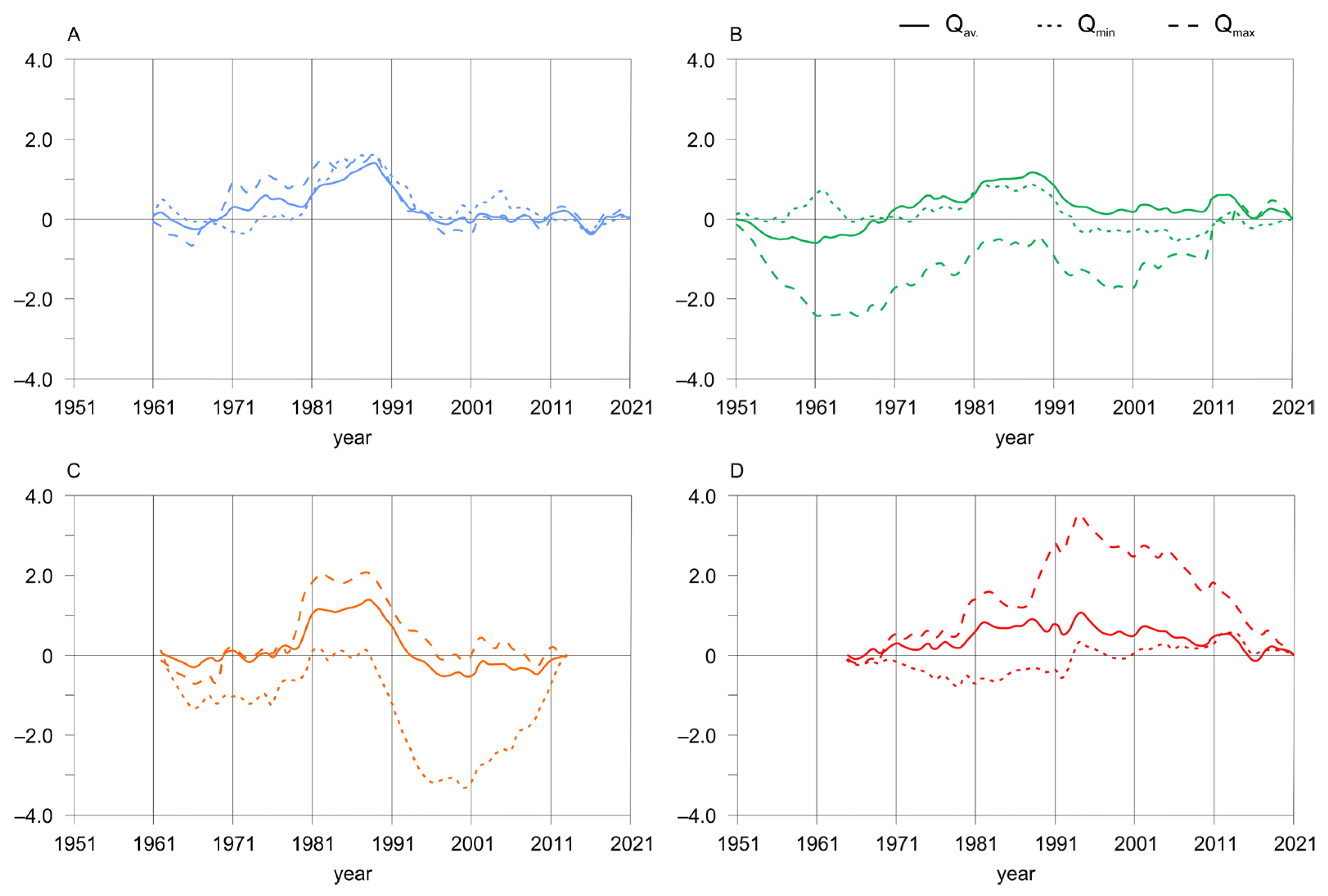
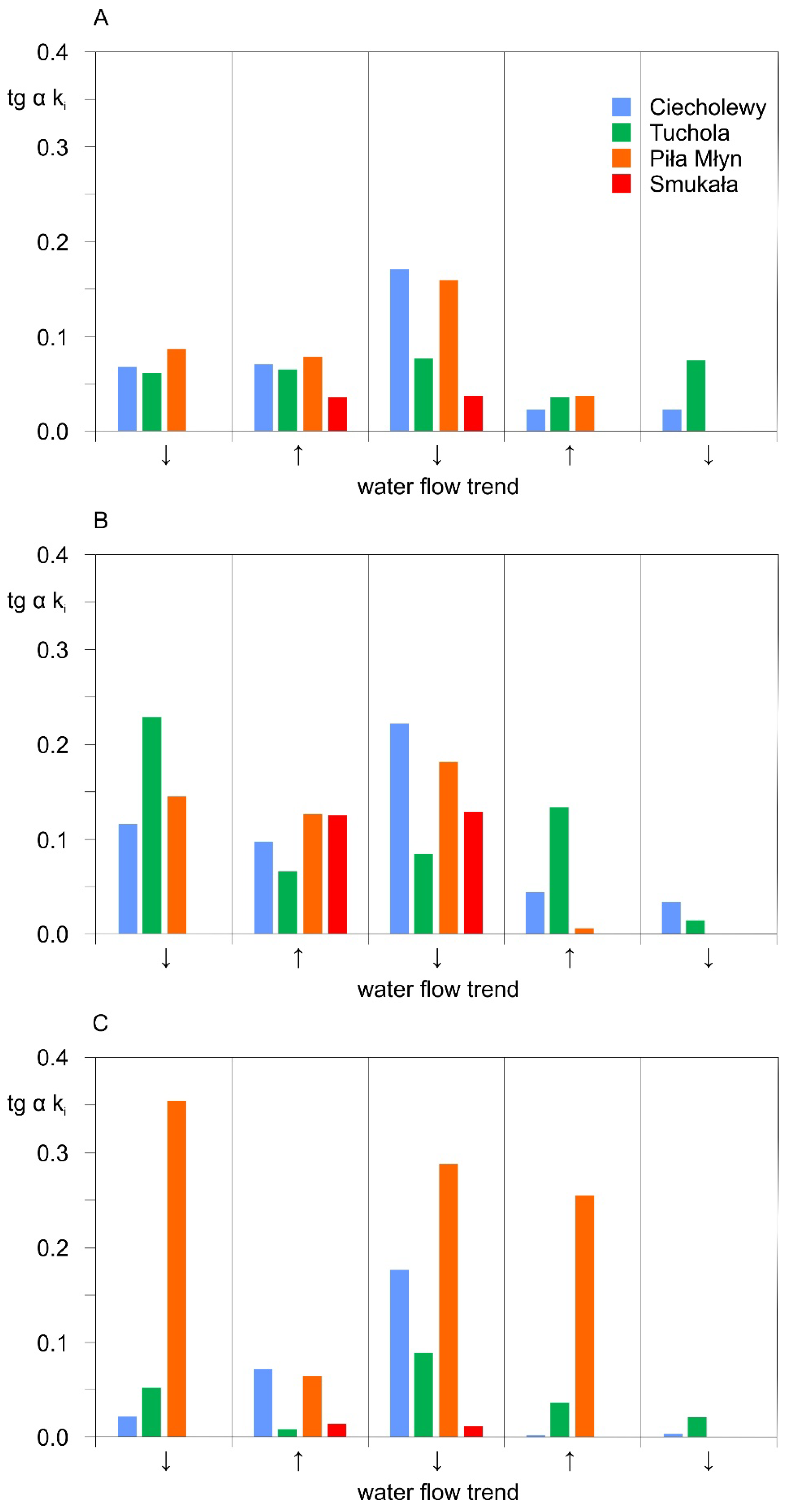
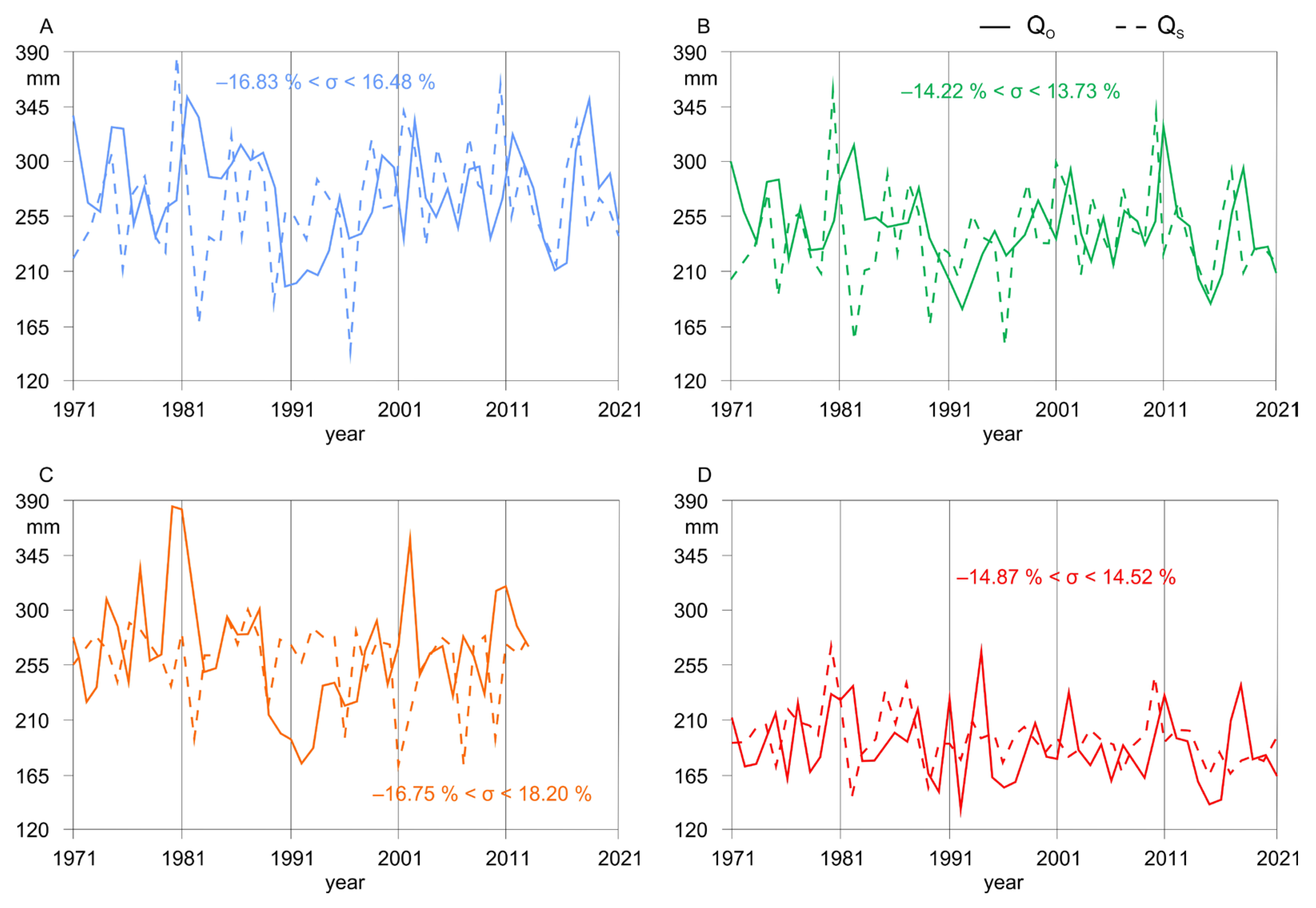
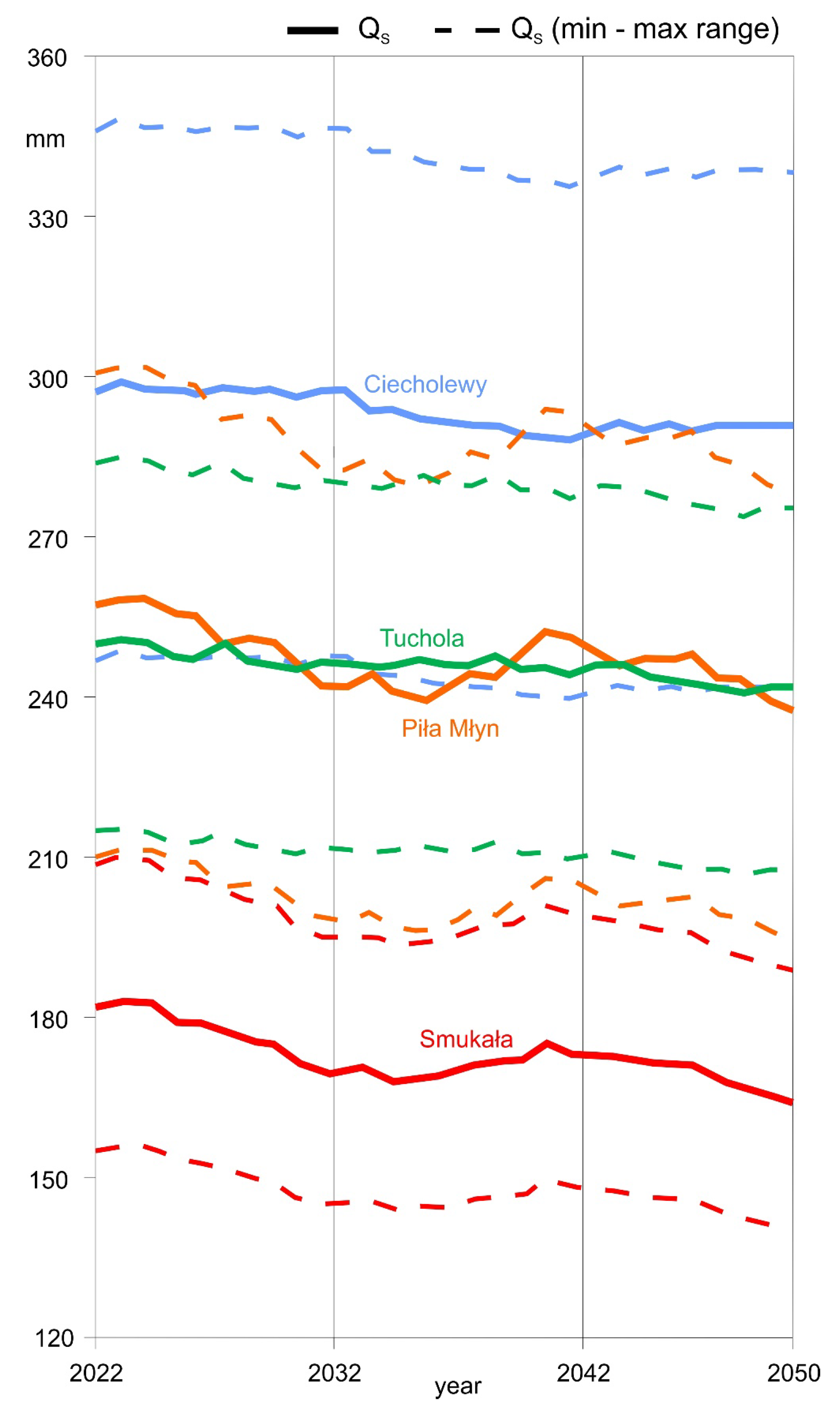
| No. | Reservoir | Year | Km | Area (in km2) | Capacity (in mln m3) | Water Damming (in m) |
|---|---|---|---|---|---|---|
| 1. | Mylof | 1848 | 123.1 | 10.5 | 16.2 | 10.0 |
| 2. | Koronowo | 1961 | 49.1 40.1 * | 14.36 | 81.0 | 24.7 |
| 3. | Tryszczyn | 1962 | 31.5 | 0.87 | 1.8 | 4.6 |
| 4. | Smukała | 1951 | 22.3 | 0.94 | 2.2 | 7.5 |
| No. | Water Gauge | A (km2·10−3) | Kilometers | Parameter | Scope of Observation |
|---|---|---|---|---|---|
| 1. | Ciecholewy | 0.712 | 166.7 | Q in m3·s−1 | 1961–2021 |
| 2. | Tuchola | 2.605 | 85.9 | 1951–2021 | |
| 3. | Piła Młyn | 2.800 | 75.1 | 1962–2013 | |
| 4. | Smukała | 4.472 | 20.1 | 1965–2021 |
| No. | Station | Latitude | Longitude | Elevation in m a.s.l. | Parameters | Scope of Observation |
|---|---|---|---|---|---|---|
| 1. | Chojnice | 53°42′55″ N | 17°31′57″ E | 164 | T, in °C P, in mm | 1971–2021 |
| 2. | Piła | 53°07′52″ N | 16°44′54″ E | 72 | 1971–2021 | |
| 3. | Toruń | 53°02′31″ N | 18°35′43″ E | 69 | 1971–2021 |
| No. | Gauging Station | c (1971–2021) | Correlation Coefficient P/c | New Formula | c′ (2022–2050) |
|---|---|---|---|---|---|
| 1. | Ciecholewy | −0.926–164.015 | −0.695 | c′ = (−0.0075 × Pa) + 6.6108 | 1.174–1.366 |
| 2. | Tuchola | −0.887–14.333 | −0.744 | c′ = (−0.0065 × Pa) + 5.4669 | 1.026–1.168 |
| 3. | Piła Młyn | −0.009–12.167 | −0.735 | c′ = (−0.0158 × Pa) + 11.767 | 1.138–1.532 |
| 4. | Smukała | −0.960–16.899 | −0.801 | c′ = (−0.0077 × Pa) + 5.6237 | 0.594–0.796 |
| Gauging Station | Full River Flow Oscillation | |||
|---|---|---|---|---|
| I | II | III | IV | |
| Ciecholewy | 1961 ↓ 1966 ↑ 1989 28 years | 1989 ↓ 1998 ↑ 2013 24 years | 2013 ↓ 2041 ↑ 2050 37 years | |
| Tuchola | 1951 ↓ 1961 ↑ 1988 37 years | 1988 ↓ 2001 ↑ 2013 25 years | 2013 ↓ 2030 ↑ 2038 25 years | 2038 ↓ 2050 12 years * |
| Piła Młyn | 1962 ↓ 1966 ↑ 1988 26 years | 1988 ↓ 2000 ↑ 2023 35 years | 2023 ↓ 2035 ↑ 2040 17 years | 2040 ↓ 2050 10 years * |
| Smukała | 1965 ↑ 1994 29 years * | 1994 ↓ 2034 ↑ 2040 46 years | 2040 ↓ 2050 10 years * | |
Disclaimer/Publisher’s Note: The statements, opinions and data contained in all publications are solely those of the individual author(s) and contributor(s) and not of MDPI and/or the editor(s). MDPI and/or the editor(s) disclaim responsibility for any injury to people or property resulting from any ideas, methods, instructions or products referred to in the content. |
© 2025 by the authors. Licensee MDPI, Basel, Switzerland. This article is an open access article distributed under the terms and conditions of the Creative Commons Attribution (CC BY) license (https://creativecommons.org/licenses/by/4.0/).
Share and Cite
Szatten, D.; Łaszyca, E.Z.; Bosino, A.; De Amicis, M.; Obodovskyi, O. Impact of Climate Conditions on the Sensitivity of Long-Term Annual River Flow in a Cascade-Dammed River System: The Brda River Case Study (Poland). Geosciences 2025, 15, 197. https://doi.org/10.3390/geosciences15060197
Szatten D, Łaszyca EZ, Bosino A, De Amicis M, Obodovskyi O. Impact of Climate Conditions on the Sensitivity of Long-Term Annual River Flow in a Cascade-Dammed River System: The Brda River Case Study (Poland). Geosciences. 2025; 15(6):197. https://doi.org/10.3390/geosciences15060197
Chicago/Turabian StyleSzatten, Dawid, Edward Zbigniew Łaszyca, Alberto Bosino, Mattia De Amicis, and Oleksandr Obodovskyi. 2025. "Impact of Climate Conditions on the Sensitivity of Long-Term Annual River Flow in a Cascade-Dammed River System: The Brda River Case Study (Poland)" Geosciences 15, no. 6: 197. https://doi.org/10.3390/geosciences15060197
APA StyleSzatten, D., Łaszyca, E. Z., Bosino, A., De Amicis, M., & Obodovskyi, O. (2025). Impact of Climate Conditions on the Sensitivity of Long-Term Annual River Flow in a Cascade-Dammed River System: The Brda River Case Study (Poland). Geosciences, 15(6), 197. https://doi.org/10.3390/geosciences15060197






